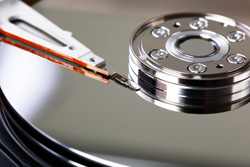Improved PMR technology for disk storage
Today practically all high-capacity information storage is based on hard disk drive (HDD) technology, which uses magnetic materials as a recording media on rotating disk platters. However, the HDD industry is undergoing a major technology transformation towards perpendicular magnetic recording (PMR), where the magnetic bits are aligned perpendicularly to the disk surface, despite PMR technology not being fully understood yet. EU-funded scientists in the 'Materials analysis based on partially correlated magnetic switching' (Mapacomas) project want to develop an accurate characterisation technique for PMR media to help industry take advantage of this technology. Specifically, researchers will aim to understand 'the physics of partially correlated reversal, which is mediated by the sufficiently strong grain-to-grain interactions'. The project will build on 'realistic microscopic modelling' to develop a numerical and analytic method from which to derive quantitatively accurate analysis schemes of magnetisation reversal as the foundation for reliable characterisation methods of PMR media. Since the Mapacomas project began, the research team in Spain has made some progress towards achieving these aims, notably managing, for example, to successfully develop a framework for the identification of PMR material properties, 'such as the exchange and magnetostatic interactions and intrinsic switching field distributions'.



